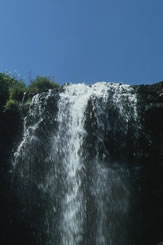Topics
- Regional water observation mechanism
- Regional Cooperation Assessment
- Water Quality Monitoring (JP)
- Water scarcity and drought (JP)
- Groundwater (JP)
- Waste water reuse (JP)
- Shared Water Resources Management (JP)
- Linking rural development and water management (JP)
- Waste management
- Water institutions
- Climate Change
- Floods
- Desalination
- Right to Water
- Irrigation
- Satellite data
- Water reports & data
- Hydrology
- Sanitation
- Gender and IWRM
- ArabWAYS
- Non-Revenue Water
- Virtual Water & Water Footprint
- WANA Water Panel
- Water Demand
- Water Governance
- Water Pricing
- Water accounts
- Water nexus Energy
- Geosciences
- Rural Management
 Desalination
Desalination
 |
Humans cannot drink saline water. But, saline water can be made into freshwater, which everyone needs everyday. The process is called desalination, and it is being used more and more around the world to provide people with needed freshwater. Desalination/Distillation is one of mankind's earliest forms of water treatment, and it is still a popular treatment solution throughout the world today. In ancient times, many civilizations used this process on their ships to convert sea water into drinking water. Today, desalination plants are used to convert sea water to drinking water on ships and in many arid regions of the world, and to treat water in other areas that is fouled by natural and unnatural contaminants. Distillation is perhaps the one water treatment technology that most completely reduces the widest range of drinking water contaminants. In nature, this basic process is responsible for the hydrologic cycle. The sun causes water to evaporate from surface sources such as lakes, oceans, and streams. The water vapor eventually comes in contact with cooler air, where it re-condenses to form dew or rain. This process can be imitated artificially, and more rapidly than in nature, using alternative sources of heating and cooling. The above diagram and information is courtesy of Desware: The Encylopedia of Desalination and Water Resources. |
- As of June 30, 2008 there were 13,869 "contracted desalination plants" worldwide, according to Global Water Intelligence and the International Desalination Association.
- Top
10 desalination countries as of June 30, 2008, accordng to Global Water
Intelligence and the International Desalination Association.
1) Saudi Arabia 10,759,693 m3/d 17% 2) UAE 8,428,456 m3/d 13% 3) USA 8,133,415 m3/d 13% 4) Spain 5,249,536 m3/d 8% 5) Kuwait 2,876,625 m3/d 5% 6) Algeria 2,675,958 m3/d 4% 7) China 2,259,741 m3/d 4% 8) Qatar 1,712,886m3/d 3% 9) Japan 1,493,158 m3/d 2% 10) Australia 1,184,812m3/d 2%
Login to add a comment
 you are not logged in
you are not logged in







